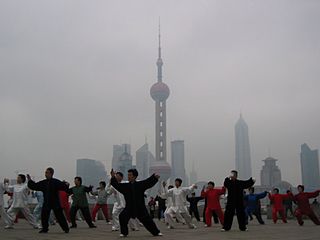The praying mantis is any insect of the order Mantodea.
Contents
Praying mantis may also refer to:
The praying mantis is any insect of the order Mantodea.
Praying mantis may also refer to:
Crane or cranes may refer to:

Northern Praying Mantis is a style of Chinese martial arts, sometimes called Shandong Praying Mantis after its province of origin. It is one of the best known styles of "Northern" kung fu and it encompasses of many styles, with the three main ones being the six-harmony style, eight-steps style and seven-star style.
Mantis is the common name of any insect in the order Mantodea, also commonly known as praying mantises.

The Chinese mantis is a species of mantis native to Asia and the nearby islands. In 1896, this species was accidentally introduced by a nursery tender at Mt. Airy near Philadelphia, United States. Tenodera sinensis often is erroneously referred to as Tenodera aridifolia sinensis because it was at first described as a subspecies of Tenodera aridifolia, but Tenodera sinensis is now established as a full species.
Chen or Ch'en may refer to:

Southern Praying Mantis is a Chinese martial art originating with the Hakka people. It is most closely associated with Hakka-origin styles such as Southern Dragon Kung Fu and Bak Mei.
Angela may refer to:

In Chinese martial arts, there are fighting styles that are modeled after animals.

The hook sword, twin hooks, fu tao, hu tou gou or shuang gou is a Chinese weapon traditionally associated with northern styles of Chinese martial arts and Wushu weapons routines, but now often practiced by southern styles as well.

There are hundreds of different styles of Chinese martial arts, each with their own sets of techniques and ideas. The various movements in kung fu, most of which are imitations of the fighting styles of animals, are initiated from one to five basic foot positions: normal upright posture and the four stances called dragon, frog, horse riding, and snake.

Tung Kong Chow Gar Tong Long, or simply Chow Gar (周家), is a southern Chinese martial art of the Hakka (客家) people. It is one of the four major schools of Southern Praying Mantis, the other schools being Chu Gar, Kwong Sai Jook Lum, and Tit Ngau. It is an aggressive style of kung fu with an emphasis on close-range fighting. These skills are developed by utilizing a range of training techniques that have been developed over several centuries.
Shaolin may refer to:
Fake or fakes may refer to:
Seven or 7Star(s) or star(s) may refer to:
Rupert "Ojiji" Harvey is a Reggae, Jazz, Funk, Dance Hall, and Roots music musician who is known for his solo records as well as his work in the Canadian band Messenjah, which had a platinum record with the hit "Cool Operator".

Mantises are an order (Mantodea) of insects that contains over 2,400 species in about 460 genera in 33 families. The largest family is the Mantidae ("mantids"). Mantises are distributed worldwide in temperate and tropical habitats. They have triangular heads with bulging eyes supported on flexible necks. Their elongated bodies may or may not have wings, but all Mantodea have forelegs that are greatly enlarged and adapted for catching and gripping prey; their upright posture, while remaining stationary with forearms folded, has led to the common name praying mantis.
Yu Chenghui, sometimes credited as Yue Sing-wai, was a Chinese actor, action director and martial artist.
A. japonica may refer to:

Pui Chan (陳培) within martial arts, is the leader of the Wah Lum Pai Martial Arts Organization. He is a sixth generation successor of the Wah Lum Pai Tam Tui Northern Praying Mantis style as well as also being a 33rd generation successor of the Shaolin Temple. He was instrumental in bringing the Wah Lum martial arts style to the United States. Chan is the last living disciple of Lee Kwan Shan, and has since studied under several other masters.